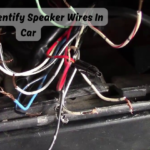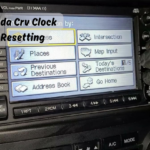If you are planning on installing a new sound system in your car, one of the first things you need to know is how to identify speaker wires. This knowledge will come in handy when connecting your speakers to the amplifier and head unit.
It may seem like a daunting task, but with some basic understanding and the right tools, identifying speaker wires can be a simple process. In this guide, we will discuss the different types of speaker wires, how to identify them in your car, and some tips for a successful installation.
Types of Speaker Wires
There are two main types of speaker wires used in cars: parallel and twisted pair.
Parallel wires:
Parallel speaker wires are usually red and black in color, and they have a positive (+) and negative (-) conductor. These wires are often used in older car models and are easily identifiable due to their distinct color coding. The positive wire is typically marked with a “+” symbol or a colored stripe, while the negative wire may have a “-” symbol or no markings at all.
Twisted pair wires:
Twisted pair speaker wires are more commonly found in newer car models. They consist of two individually insulated wires that are twisted together to reduce interference and noise. These wires can be either the same color or different colors, making it trickier to identify them at first glance.
Identifying Speaker Wires
To successfully identify speaker wires in your car, you will need a few tools:
- A speaker wire tester or multimeter
- Electrical tape
- Wire strippers
- Scissors or a knife (for stripping the wires)
Once you have these tools ready, follow these steps:
Locate the wires:
The first step in identifying speaker wires is to locate them. In most cars, the speakers are located in the doors or on the rear deck. If you are unsure where your speakers are, consult your car’s manual.
Also, make sure to disconnect the negative (-) terminal of your car battery before starting this process. This will prevent any electrical mishaps or potential damage to your sound system.
Keep in mind that some cars may have factory-installed amplifiers or wiring harnesses, which can complicate the identification process. In these cases, it is best to consult a professional for assistance.
Once you have located the speaker wires, you can move on to testing them.
Test the wires:
Using your speaker wire tester or multimeter, touch one probe to the positive wire and the other probe to the negative wire. If your tester or multimeter indicates a reading, then those are your speaker wires.
If you do not have a tester or multimeter, another way to test the wires is by connecting them to an existing speaker in your car. Play some music and listen for sound coming from the speaker. If there is no sound, you have identified the wrong wires.
Label the wires:
After testing and identifying the speaker wires, label them accordingly. You can use colored tape or markers to designate which wire is positive and which one is negative. This will make it easier when connecting your speakers to the amplifier and head unit.
Connect the wires:
Now that you have identified and labeled the speaker wires, it’s time to connect them to your sound system. Remember to match the positive and negative wires correctly for each speaker.
Plus, it’s always a good idea to double-check your connections before securing them in place.
Secure the connections:
Once all the wires are connected, use electrical tape to secure them and prevent any accidental loosening or exposure. Make sure to wrap each connection tightly and neatly for a clean and secure installation.
If you have used wire strippers to strip the ends of the wires, make sure there are no exposed wires that can touch each other or any metal surfaces.
With all the connections and labeling done, you can now reconnect your car battery and test out your new sound system!
Tips for a Successful Installation
Here are some additional tips to keep in mind for a successful speaker wire identification and installation process:
- Double-check your connections before securing them in place.
- Use wire strippers or scissors to strip the ends of the wires cleanly.
- Make sure there are no exposed wires that can cause a short circuit.
- If you encounter any difficulties, consult a professional for assistance.
- Always disconnect the car battery before starting any electrical work.
- Take your time and be patient, rushing through the process can lead to mistakes.
Benefits of Knowing How to Identify Speaker Wires
Knowing how to identify speaker wires in your car has several benefits:
- It allows you to confidently install a new sound system in your car.
- You can troubleshoot any issues with your speakers or sound system.
- It saves you time and money by not having to rely on professional installation services.
- You have the satisfaction of successfully completing a DIY project.
- You can customize your sound system according to your preferences.
FAQs
Are speaker wires universal?
No, speaker wires are not universal. They come in different types and sizes depending on the car model and sound system.
Can I use any type of wire for my speakers?
It is recommended to use high-quality speaker wires specifically designed for car audio systems to ensure optimal performance and safety.
Do all cars have the same color coding for speaker wires?
No, color coding for speaker wires can vary between car models and manufacturers. It’s best to consult your car’s manual or use a tester/multimeter to correctly identify the wires.
Can I install a sound system in my car without identifying the speaker wires?
It is not recommended to install a sound system without properly identifying and labeling the speaker wires. This can result in incorrect connections, which may damage your speakers or sound system.
Conclusion
Identifying speaker wires in your car may seem daunting, but with the right tools and steps, it can be done easily. By following the tips and instructions outlined in this guide, you can confidently install a new sound system or troubleshoot any issues with your current setup. Knowing how to identify speaker wires not only saves you time and money but also gives you the satisfaction of successfully completing a DIY project.
Remember to always prioritize safety and consult a professional if you encounter any difficulties. Now go ahead and upgrade your car’s sound system with the newfound knowledge of identifying speaker wires! So, this guide is not just about identifying the wires but also about installation tips, benefits of knowing how to identify speaker wires, FAQs and a conclusion summarizing the process. With this information, you can confidently tackle any speaker wire identification and installation projects in the future.










